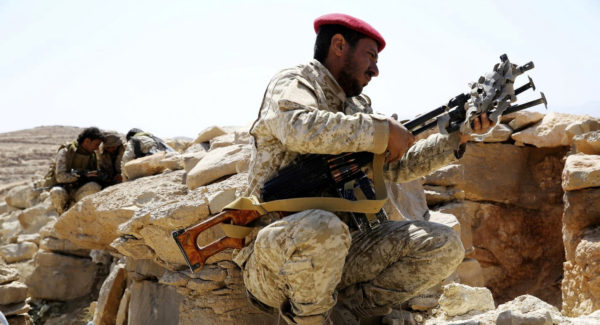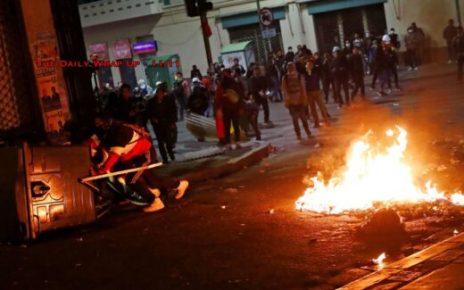Saudi Arabia killed three peaceful demonstrators protesting the kingdom’s takeover of local natural resources in Yemen’s eastern province of al-Mahrah, threatening to bring the its bloody war to Yemen’s last relatively peaceful region.
AL-MAHRAH, YEMEN — Three protesters were killed on November 14 when a Saudi armored vehicle raided a peaceful sit-in and fired live ammunition into crowds of demonstrators in the Tunnel District of Yemen’s eastern al-Mahrah province. The demonstrators were protesting the construction of a new Saudi military base near the Nashton seaport in Yemen’s al-Anfaq district.
“We gathered around the new military base in an attempt to stop its construction,” Masaud K.A, who participated in the protests, told MintPress. “The Saudi soldiers fired on us, killing Nasser Kalashat and two others.” The protest coincided with the one-year anniversary of Saudi forces entering the province.
Several months ago, residents in the al-Mahrah province organized their first peaceful sit-in rejecting Saudi policies in their country as well as the kingdom’s dominance over vital infrastructure in the area. Seventeen percent of petroleum imports to Yemen enter from Oman through a border crossing in al-Mahrah, which, along with the province’s seaport and airport, is under the control of Saudi Arabia and the United Arab Emirates.
Local residents reject the build-up of Saudi troops in al-Mahrah, which has expanded recently with the construction of a number of military camps and new security checkpoints. ”Saudi Arabia has already set up their military bases in the province,” said Ali Salem al-Englizi, one of the leaders of the demonstrations, “but there is no need to because the Houthis haven’t come to al-Mahrah and we didn’t ask them to help keep us safe.”
Last week, additional Saudi soldiers along with tanks and artillery arrived at al-Ghaida, the administrative capital of al-Mahrah, without coordinating with local authorities, a Yemeni official, who spoke on condition of anonymity, told MintPress.
Over the weekend, hundreds of Saudi forces were deployed to newly built camps in the al-Ghaida Airport and the Nashton Port, as well as local oil-rich regions. Over 100 soldiers, along with armored military vehicles, were also deployed to the entrances leading to al-Ghaida, according to a Yemeni official and confirmed by al-Mahrah residents.
Residents of al-Mahrah say the military bases vary in size, some little more than 100 Saudi soldiers along with local mercenaries enclosed by fencing. Others, such as those seen in the Nashton port and al-Ghaida airport, are far more substantial and include heavy military equipment, a control center, and training facilities.
Saudi Arabia claims that its checkpoints and military bases in al-Mahrah are needed to combat arms and drug smuggling, but according to Ali bin Salem al-Huraizy, al-Mahrah’s former deputy governor, smuggling is just a pretext for a Saudi takeover of the province:
There is no smuggling in al-Mahrah, and no need for the Saudis; the military bases were built in residential areas, not in areas where smuggling would happen.”
Saudis bring violence to Yemen’s last peaceful place
Following the Saudi attack on the sit-in, violent clashes erupted in some places in al-Mahrah. Some protesters wrested weapons from the hands of Saudi troops and witnesses say more Saudi troops and mercenaries were deployed to the district and have continued to patrol the area.
“If we are being attacked we will respond as much as we can,” Amer Saad, the head of the peaceful sit-in committee in al-Mahrah told journalists. “We will not allow this place to be turned into a Saudi camp.”
In a statement issued on Friday, the leadership of the sit-in committee accused Saudi Arabia of trying to drag peaceful protests in the province towards violence, saying, “the Tunnels checkpoint incident was a challenge to the peaceful city and showed a desire to drag it towards chaos.”
Yemen analysts say the Saudi attack on peaceful protests threatens to bring violence to the relatively peaceful region. Al-Mahrah’s tribes held a meeting to discuss how to react to the killing of protesters, but many residents feel force may be needed to combat the Saudi aggression. Masaud K.A, a local resident of al-Mahrah, said: “We will not betray the blood of the protesters as the tribes of al-Mahrah are discussing how to react. Soon we will react in the proper way.”
Yemeni strategic and military expert Brigadier Abdullah al-Jafri expects the al-Mahrah protest to spark a diplomatic falling out between Oman and Saudi Arabia. Saudi Arabia accuses Oman of inciting al-Mahrah residents to take part in demonstrations.
According to al-Jafri, the peaceful protests could turn into a full-fledged military resistance hearkening back to Yemen’s 1964 revolution in the south, which began in al-Mahrah and led to the creation of the Union of Workers Republic. The revolution spread across the restive southern province and ended with the expulsion of British occupiers from the south.
Undermining peaceful protests
In an effort to quell the protests, Saudi Arabia has stationed military forces at all entrances leading to al-Ghaida, and according to local residents, a curfew has been imposed in the city along with a crackdown that led to the arrest of local activists.
Protest leaders told MintPress that Saudi Arabia has also attempted to bribe them into giving up the sit-ins. Ali al-Hadhrami, a Yemeni political activist, confirmed that the bribes have been rejected and that protesters vow to continue their fight against what they see as a violation of Yemen’s sovereignty by Saudi Arabia and the United Arab Emirates.
As it has done in the Yemeni cities of Aden and Hadramout, local residents say that Saudi Arabia has tried to create parallel protest groups that engage in violence so they can justify a crackdown and undermine popular support for the sit-ins.
From peaceful protest to armed resistance
Al-Mahrah residents see the build-up of Saudi troops in a region that has remained largely immune to the broader war in Yemen as malign and colonial. The province is a largely peaceful area that has been mostly spared from Yemen’s three-year war. Moreover, local Yemeni forces stationed in al-Mahrah have typically shown unwavering support for the Saudi coalition.
“There are forces that are present in peaceful Socotra and al-Mahrah in numbers that can’t be fathomed,” Zaid al-Gharsi, a Yemeni journalist specializing in southern Yemen, told MintPress. “There are illegitimate troops in these areas. Are Houthi forces being fought by the coalition here? The answer is a big no!”
Faced with growing local discontent, in June the Saudis promised to hand all bases and facilities in their control over to Yemeni forces and exit the al-Mahrah region within two months, but by November it was clear that the Saudis weren’t going anywhere. Earlier this month, Saudi Arabia tried to set up four new military bases in Sayhut, but residents prevented them from doing so.
As a result of the continued Saudi expansion in the region, the leadership of the Al-Mahrah peaceful sit-in committee announced a new phase of escalation in Friday press conference, confirming that it will continue its activities rejecting the Saudi military presence. “We are here to say to Saudi Arabia that today we express our rejection in a peaceful way, tomorrow we will say it with our weapons.”
Saudis’ strategic interest
Despite the ongoing demonstrations, Saudi Arabia has continued to pursue its strategic interests in southern Yemen, including the construction of an oil shipping port in al-Mahrah on the coast of the Arabian Sea, a move rejected by al-Mahrah residents.
In late September, MintPress revealed that Saudi Arabia began construction on a pipeline in al-Mahrah that would allow the kingdom to transport oil directly to the Arabian Sea, bypassing the Strait of Hormuz and the Bab-el-Mandeb Strait. The new pipeline would allow the kingdom to export oil from its refineries through al-Mahrah and the Khareir district in the Rub’ al Khali Desert, the largest contiguous sand desert in the world, which lies in Yemen’s northeast.
Adding to the tension, the Saudis have significantly curtailed the areas in which local fishermen can operate under the pretext of combating smuggling, preventing them from fishing around the major port of Nashton. At 560 km long, al-Mahrah’s coastline is the longest of any province in Yemen.
Despite their support of the Saudi-led coalition and their being free from the presence of the Houthi resistance, Yemen’s southern provinces, including al-Mahrah and the strategic island of Socotra, have been fully controlled and managed by Saudi Arabia and UAE. They have peppered the region with permanent military bases — including on Yemen’s southern islands, such as Miyoun Island, which offers strategic control of the Bab al-Mandab Strait.
Saudis oblivious to dangers and consequences
To fulfill its strategic interests in al-Mahrah, Saudi Arabia has adopted policies without a realistic reading of their dangers and consequences, according to Abaad Studies and Research Center, a Yemeni research center closely aligned with Saudi coalition allies in the country. As Saudi Arabia dismantles traditional social structures, ideological systems, and political parties, and militia alternatives have spontaneously emerged.
For example, the Saudi-led coalition has established highly trained and equipped Salafist paramilitary forces in al-Mahrah, dubbed the “Mahri Elite Force.” The group is modeled around other coalition-backed mercenary militants operating in Yemen, including the Hadhrami Elite militants in Hadhramaut province, the Shabwani Elite militants in Shabwa, and the Pioneer Security Belt militants (al-Hizam) brigades in Aden. These paramilitary forces operate outside of local authorities and are comprised of local tribes that have close ties to Saudi Arabia.
According to a statement from the peaceful sit-in committee, the Saudi military presence in al-Mahrah has essentially gutted the local security apparatus, especially with the presence of armed militias supported by Saudi Arabia, while the militias are weakening sovereign security forces.
Like many paramilitary forces created by the Saudi-led coalition in Yemen, the Mahri Elite Force was formed from members of specific tribes, not on the basis of one national army for the country as a whole, exacerbating tribal differences, reviving the desire for revenge among tribes, and creating the desire for separate states.
Moreover, according to the Abaad Studies and Research Center, Saudi Arabia has supported the fragmentation of Yemen’s south to make it easier to control the country in the future through tools that are currently being created, including regional media, and partisan and political groups that have historical differences.
Saudi Arabia and the UAE are also using militias for reprisal against opponents, such as the burning of the headquarters of political parties and newspapers, the pursuit of activists, kidnapping and assassinations of resistance leaders, preachers, and parties who refuse to subject themselves to the coalition.
Former Yemeni President Abdrabbuh Mansour Hadi visited al-Mahrah in August. Ostensibly, he was there to promote the launch of reconstruction projects in partnership with the Saudis, including building a water purification plant, power plant, and hospitals. After his visit to al-Mahrah, the Saudis constructed six new military bases across the province.
Source: www.mintpressnews.com




